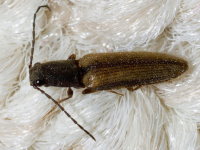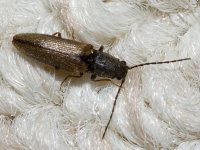Phylum Arthropoda (Arthropods) ➔ Subphylum Hexapoda (Hexapods) ➔ Class Insecta (Insects) ➔ Order Coleoptera (Beetles) ➔ Family Elateridae (Click beetles)
Athous (Orthathous) bicolor (Goeze, 1777)
Zweifarbiger Laubschnellkäfer
Synonyms and other combinations:
Elater bicolor Goeze, 1777 | Athous longicollis (Olivier, 1790) | Elater longicollis Olivier, 1790 |
Distribution:
From Southern Russia via Southern and Central Europe westwards to the Iberian Peninsula, British Islands.Habitat:
Preferably in sunny, open terrain with low vegetation.Description:
Body length 8 - 11 mm; finely and densely hairy; pronotum in male dull, slender, narrowed towards the front and much longer than broad, in female faintly shiny, slightly rounded laterally and somewhat longer than broad; colouration variable; head and pronotum mostly dark; elytra brownish yellow, often with blackened lateral margin and ± broadly blackened suture (nominate form), very rarely completely dark; legs yellowish red, femora and forelegs mostly black. There are also unicoloured light brownish yellow or brownish red specimens.Biology:
The adults of Athous bicolor appear around May and are most commonly found in Germany in June and July. They visit flowers and like to rest on umbellifers in warm weather. The males fly in the evening hours. The females usually hide in the low vegetation. After mating in June, the females lay their eggs into the ground. The larvae (wireworms) develop in the soil and feed on the roots of grasses and various herbs.References, further reading, links:
- Actenicerus siaelandicus
- Agriotes acuminatus
- Agriotes pallidulus
- Agriotes pilosellus
- Agriotes ustulatus
- Agrypnus murinus
- Ampedus balteatus
- Ampedus sp.
- Anostirus purpureus
- Aplotarsus incanus
- Athous bicolor
- Athous haemorrhoidalis
- Athous subfuscus
- Ctenicera pectinicornis
- Dalopius marginatus
- Denticollis linearis
- Ectinus aterrimus
- Melanotus sp.
- Selatosomus aeneus
- Chequered Click Beetle
- Dusky Wireworm
- Lined Click Beetle
- Unidentified larva


